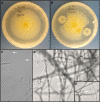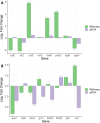Comparative transcriptome analysis reveals the biocontrol mechanism of Bacillus velezensis E68 against Fusarium graminearum DAOMC 180378, the causal agent of Fusarium head blight
- PMID: 36701319
- PMCID: PMC9879434
- DOI: 10.1371/journal.pone.0277983
Comparative transcriptome analysis reveals the biocontrol mechanism of Bacillus velezensis E68 against Fusarium graminearum DAOMC 180378, the causal agent of Fusarium head blight
Abstract
Fusarium graminearum is the causal agent of Fusarium Head Blight, a serious disease affecting grain crops worldwide. Biological control involves the use of microorganisms to combat plant pathogens such as F. graminearum. Strains of Bacillus velezensis are common biological control candidates for use against F. graminearum and other plant pathogens, as they can secrete antifungal secondary metabolites. Here we study the interaction between B. velezensis E68 and F. graminearum DAOMC 180378 by employing a dual RNA-seq approach to assess the transcriptional changes in both organisms. In dual culture, B. velezensis up-regulated genes related to sporulation and phosphate stress and down-regulated genes related to secondary metabolism, biofilm formation and the tricarboxylic acid cycle. F. graminearum up-regulated genes encoding for killer protein 4-like proteins and genes relating to heavy metal tolerance, and down-regulated genes relating to trichothecene biosynthesis and phenol metabolism. This study provides insight into the molecular mechanisms involved in the interaction between a biocontrol bacterium and a phytopathogenic fungus.
Copyright: © 2023 Liang et al. This is an open access article distributed under the terms of the Creative Commons Attribution License, which permits unrestricted use, distribution, and reproduction in any medium, provided the original author and source are credited.
Conflict of interest statement
The authors have declared that no competing interests exist.
Figures




Similar articles
-
A comprehensive understanding of the biocontrol potential of Bacillus velezensis LM2303 against Fusarium head blight.PLoS One. 2018 Jun 1;13(6):e0198560. doi: 10.1371/journal.pone.0198560. eCollection 2018. PLoS One. 2018. PMID: 29856856 Free PMC article.
-
Edeine B1 produced by Brevibacillus brevis reduces the virulence of a plant pathogenic fungus by inhibiting mitochondrial respiration.mBio. 2024 Jul 17;15(7):e0135124. doi: 10.1128/mbio.01351-24. Epub 2024 Jun 11. mBio. 2024. PMID: 38860787 Free PMC article.
-
Bacillus velezensis RC 218 as a biocontrol agent to reduce Fusarium head blight and deoxynivalenol accumulation: Genome sequencing and secondary metabolite cluster profiles.Microbiol Res. 2016 Nov;192:30-36. doi: 10.1016/j.micres.2016.06.002. Epub 2016 Jun 8. Microbiol Res. 2016. PMID: 27664721
-
Surfactin inhibits Fusarium graminearum by accumulating intracellular ROS and inducing apoptosis mechanisms.World J Microbiol Biotechnol. 2023 Oct 12;39(12):340. doi: 10.1007/s11274-023-03790-2. World J Microbiol Biotechnol. 2023. PMID: 37821760 Review.
-
Recent advances in genes involved in secondary metabolite synthesis, hyphal development, energy metabolism and pathogenicity in Fusarium graminearum (teleomorph Gibberella zeae).Biotechnol Adv. 2014 Mar-Apr;32(2):390-402. doi: 10.1016/j.biotechadv.2013.12.007. Epub 2014 Jan 2. Biotechnol Adv. 2014. PMID: 24389085 Review.
Cited by
-
Acid-resistant Bacillus velezensis effectively controls pathogenic Colletotrichum capsici and improves plant health through metabolic interactions.Appl Environ Microbiol. 2025 Jul 23;91(7):e0034025. doi: 10.1128/aem.00340-25. Epub 2025 Jun 23. Appl Environ Microbiol. 2025. PMID: 40548728 Free PMC article.
-
Biocontrol of Fusarium head blight in rice using Bacillus velezensis JCK-7158.Front Microbiol. 2024 Jun 10;15:1358689. doi: 10.3389/fmicb.2024.1358689. eCollection 2024. Front Microbiol. 2024. PMID: 38915299 Free PMC article.
-
Characterization and Biocontrol Efficacy of Bacillus velezensis GYUN-1190 against Apple Bitter Rot.Plant Pathol J. 2024 Dec;40(6):681-695. doi: 10.5423/PPJ.OA.05.2024.0076. Epub 2024 Dec 1. Plant Pathol J. 2024. PMID: 39639671 Free PMC article.
-
Strong Opponent of Walnut Anthracnose-Bacillus velezensis and Its Transcriptome Analysis.Microorganisms. 2023 Jul 26;11(8):1885. doi: 10.3390/microorganisms11081885. Microorganisms. 2023. PMID: 37630445 Free PMC article.
-
Dual RNA-sequencing of Fusarium head blight resistance in winter wheat.Front Plant Sci. 2024 Jan 4;14:1299461. doi: 10.3389/fpls.2023.1299461. eCollection 2023. Front Plant Sci. 2024. PMID: 38239218 Free PMC article.
References
-
- Langevin F, Eudes F, Comeau A. Effect of Trichothecenes Produced by Fusarium graminearum during Fusarium Head Blight Development in Six Cereal Species. Eur J Plant Pathol. 2004;110: 735–746. doi: 10.1023/B:EJPP.0000041568.31778.ad - DOI
-
- Pestka J. Toxicological mechanisms and potential health effects of deoxynivalenol and nivalenol. World Mycotoxin J. 2010;3: 323–347. doi: 10.3920/WMJ2010.1247 - DOI
-
- Wilson W, Dahl B, Nganje W. Economic costs of Fusarium Head Blight, scab and deoxynivalenol. World Mycotoxin J. 2018;11: 291–302. doi: 10.3920/WMJ2017.2204 - DOI
Publication types
MeSH terms
Supplementary concepts
LinkOut - more resources
Full Text Sources

